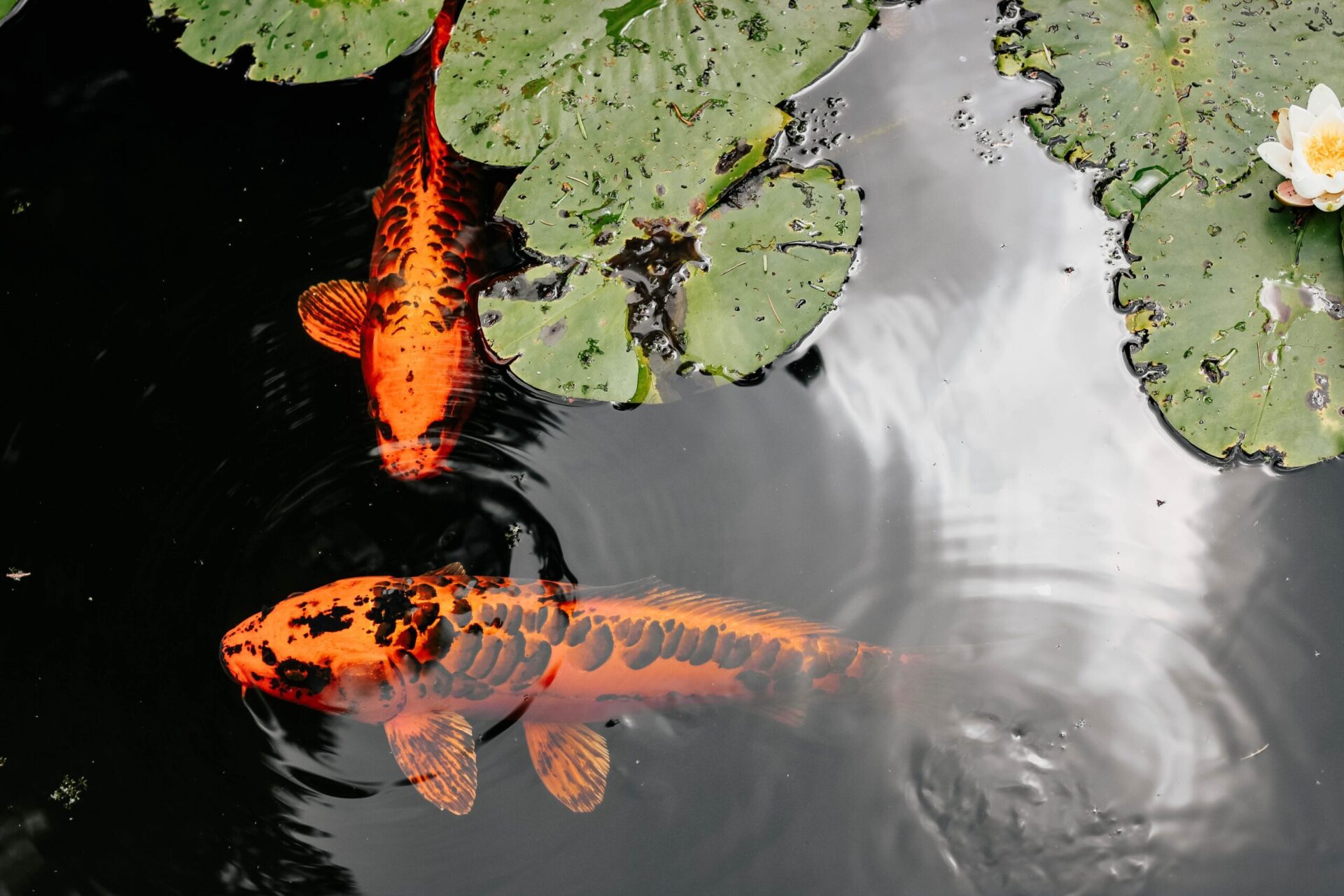Algae are a common problem for pond owners, but excessive growth can quickly turn your beautiful fish pond into a murky green mess. While a small amount of algae is normal and even beneficial for your pond’s ecosystem, uncontrolled blooms can compete with fish and aquatic plants for oxygen, leading to imbalances and potential harm to your pond life.

After investing in a fish pond for your home or property, chances are you want a well-maintained pond that stays clean and clear year-round. At Atlantis Water Gardens, we understand how frustrating algae overgrowth can be, and our fish pond installers near me in Randolph are here to help. Below, we’ll explore safe and effective ways to remove algae from your pond without harming your fish.
Why Does Algae Grow in Ponds?
Algae thrive in ponds due to excess nutrients, particularly nitrogen and phosphorus. These nutrients often enter the water through fish waste, decaying leaves, uneaten fish food, and runoff from fertilizers. When combined with warm temperatures and sunlight, these factors create the perfect environment for algae to flourish.
Some common types of algae found in ponds include:
- Green Water Algae: Free-floating algae that turn the water green and cloudy.
- String Algae (Filamentous Algae): Hair-like strands that attach to rocks, plants, and pond liners.
- Blue-Green Algae (Cyanobacteria): Toxic algae that can harm fish and even pets.
If left unchecked, algae can deplete oxygen levels, harm fish, and make your pond look unappealing. Fortunately, there are several ways to keep your pond water clear and free from algae without resorting to harmful chemicals.
1. Manually Remove Algae with a Rake
One of the simplest ways to reduce algae in your pond is to physically remove it. Using a pond rake or skimmer net, scoop out as much algae as possible. This method is especially effective for string algae, which tend to clump together in mats.
Tips for Manual Removal
- Use a plastic rake if you have a rubber liner to prevent damage.
- Be gentle to avoid disturbing fish and beneficial bacteria.
- Dispose of removed algae far from the pond to prevent nutrients from washing back in.
While manual removal is a quick fix, it doesn’t address the root cause of the algae problem, so additional steps are necessary.
2. Introduce Barley Straw for Natural Algae Prevention
Barley straw is a time-tested, natural method for algae control. When submerged in water, barley decomposes and releases compounds that inhibit algae growth.
How to Use Barley Straw in Your Pond
- Place a bundle of barley straw in a mesh bag and let it float near the center of your pond.
- Use approximately 8 ounces (230g) per 1,000 gallons of water.
- Replace the barley straw every 6 months for continued effectiveness.
This method is completely safe for fish and helps maintain long-term algae control.
3. Add Beneficial Bacteria to Your Pond
Beneficial bacteria are essential for breaking down organic waste and reducing the nutrients that fuel algae growth. These bacteria naturally consume fish waste, uneaten food, and decaying plant matter, preventing excess nutrients from accumulating in your pond.
How to Use Beneficial Bacteria
- Choose fish-safe bacteria tablets or liquid treatments.
- Add one tablet per 1,000 gallons of water (follow product instructions).
- Apply bacteria regularly, especially in spring and summer when algae growth is most aggressive.
Promoting a balanced ecosystem is fish pond installation 101, and beneficial bacteria help keep your pond clear and healthy.
4. Install a UV Sterilizer for Crystal-Clear Water
A UV sterilizer is a highly effective tool for eliminating free-floating algae, which cause green water. The ultraviolet light destroys algae at a microscopic level, preventing it from multiplying.
How UV Sterilization Works
- The pond water passes through the UV light chamber, killing algae cells.
- Within a few days, the green tint in the water begins to fade.
- Dead algae particles can then be filtered out or removed manually.
Important Tips!
- Remove excess algae before installing the UV sterilizer to maximize effectiveness.
- Avoid using water clarifiers at the same time, as they can harm fish gills.
- Choose the correct UV wattage for your pond size.
A UV sterilizer is a great long-term investment for maintaining clear, algae-free water.
5. Add Floating Aquatic Plants to Reduce Nutrients
Plants are natural competitors of algae because they absorb the same nutrients that algae need to grow. Adding floating and submerged plants like waterlilies can help starve algae while enhancing your pond’s beauty.
Best Plants for Algae Control
- Water Lilies: Provide shade, reducing sunlight exposure.
- Water Hyacinths: Absorb excess nutrients quickly.
- Anacharis (Elodea): Oxygenates the water and competes with algae.
A well-planted pond naturally maintains balance, reducing the chances of an algae bloom.
6. Reduce Excess Fish Waste and Uneaten Food
Overfeeding fish is a common cause of algae problems. Uneaten fish food decomposes, releasing nutrients that fuel algae growth. Similarly, fish waste adds nitrogen to the water, contributing to green water issues.
How to Prevent Nutrient Overload
- Feed fish only what they can consume in 2-3 minutes.
- Remove uneaten food promptly.
- Use a high-quality, low-phosphorus fish food to minimize waste.
- Keep fish populations in check to avoid overloading the ecosystem.
By managing fish feeding habits, you can significantly reduce algae growth.
7. Regular Pond Maintenance and Filtration
Routine maintenance is essential for preventing algae problems before they start. A properly sized pond filter and skimmer can help keep the water clean by removing debris before it decomposes.
Essential Maintenance Tips
- Clean filters and skimmers regularly.
- Perform partial water changes (10-20%) every few weeks.
- Remove decaying leaves and organic matter to prevent nutrient buildup.
Consistent care ensures your pond stays clean and balanced year-round.
Need Professional Pond Care? Contact Atlantis Water Gardens!
If you’re struggling with persistent algae issues and need help from pro fish pond installers near you in Randolph, NJ, our team at Atlantis Water Gardens can help. We specialize in custom pond design, installation, and maintenance to keep your water feature looking its best.
Contact us today or give us a call at 973-627-0515 to schedule a consultation. Let us help you create a stunning, algae-free pond that enhances your outdoor space!

Founder & Master Pond Builder
Jaak Harju is the founder and master pond builder of Atlantis Water Gardens, a family-owned design and build firm specializing in natural-looking ponds, waterfalls, and ecosystem water features. Since 2000, Jaak has dedicated his career to creating outdoor environments that inspire connection with nature.
With a background in landscape design and construction, Jaak brings artistry and precision to every project. He’s known nationally for his creative stonework, ecological pond design, and educational outreach within the pond-building community. Through his work, videos, and collaborations with other Aquascape-certified contractors, Jaak has helped redefine backyard water features as sustainable, living ecosystems.